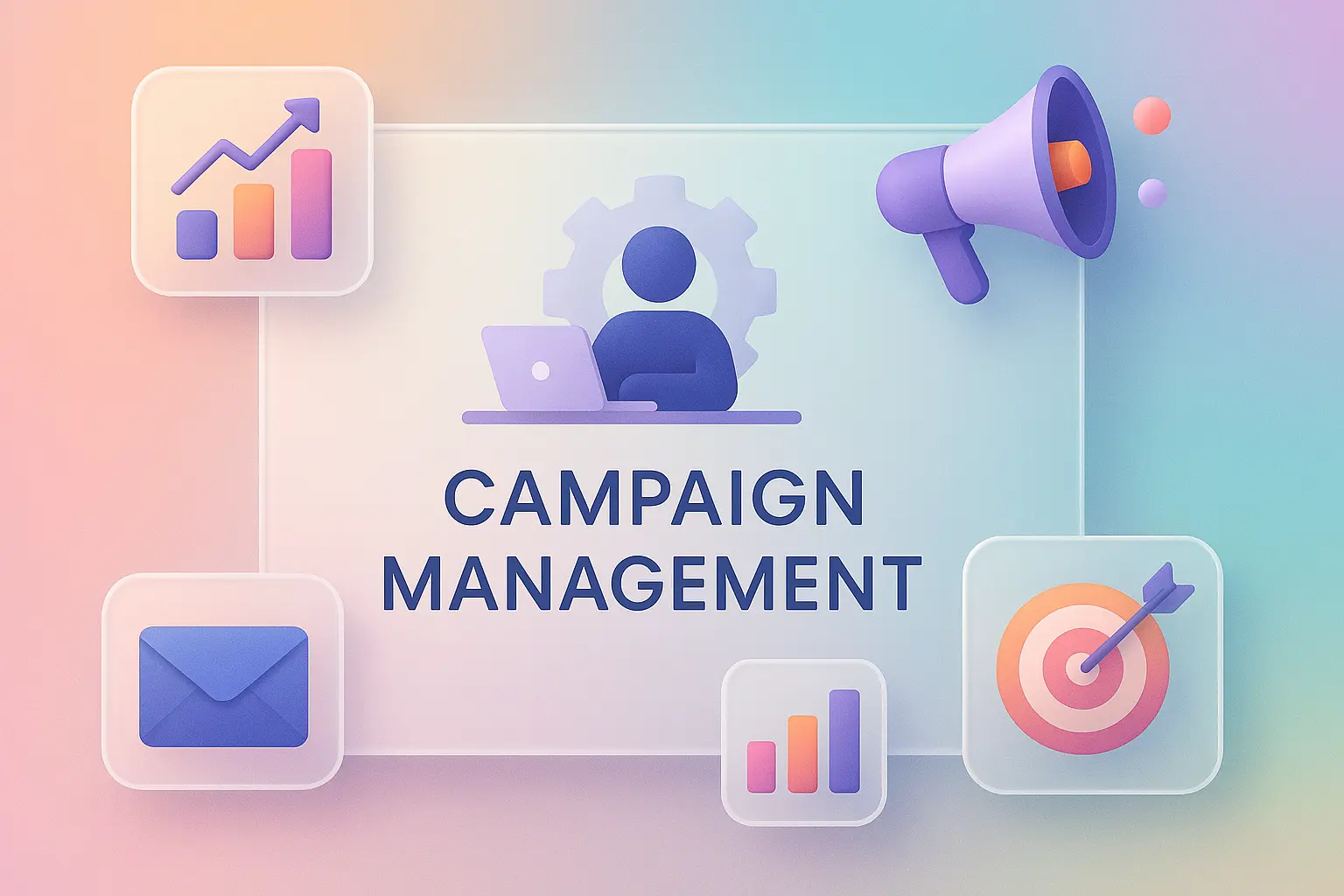Lead Management Process – Importance, Stages & Best Practices
- June 3, 2024
- 16 mins read
- Listen

What happens when your business doesn’t have a well-defined lead management process in place? You might then struggle to track, nurture, and convert potential customers.
Not having a structured approach to managing leads can result in missed opportunities and wasted marketing efforts. Worse still, the absence of a proper lead management process might risk inefficiency and poor customer relationships. This can compromise your sales performance and growth projections.
On the other hand, when you have a system for lead management, it ensures that every lead is followed up and qualified systematically. It also helps guide every lead through the sales funnel, improving the conversion rates.
In addition, managing leads successfully shows that you engage with your audience timely, and that can enhance the customer experience as well. When leads are managed well, the entire process leads to better data and insights into customer behavior. This can give you an opportunity to refine your marketing strategies and be judicious with resource allocation.
In this blog, we will discuss lead management in detail, and understand the process, importance, stages, benefits, and steps to build one for your business.
Before digging deep, let’s first start with the definition…
What is Lead Management?
Lead management is the process of keeping track of when leads become customers. It involves a series of steps to analyze data about leads and understand how likely they are to become a paying customer.
In other words, lead management is also a structured approach to capturing, tracking, and nurturing potential customers through the sales funnel until they are ready to make a purchase.
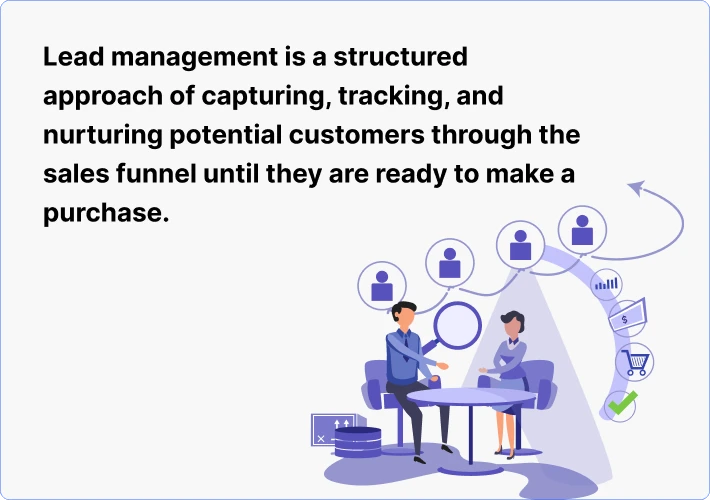
For your business, a lead is a person who may engage with your product, or service, or show interest in buying from you. Since they have shown interest, you might believe they will someday buy from you. However, just showing interest means those leads are at a very early stage of the sales funnel and you need to work a lot to guide them through.
Your focus should be on nurturing those leads into prospects and helping them move through your sales funnel. At any point in time, you may have lots of leads in your sales pipelines, and lead management is about managing ( organizing ) those leads for conversion.
What is the Lead Management Process?
The lead management process is a systematic approach to nurturing leads and converting them into customers. Businesses use this process to identify, capture, track, and nurture leads with a focus on conversions. When the lead management process is used, a business can improve the efficiency of its marketing strategies and streamline sales efforts.
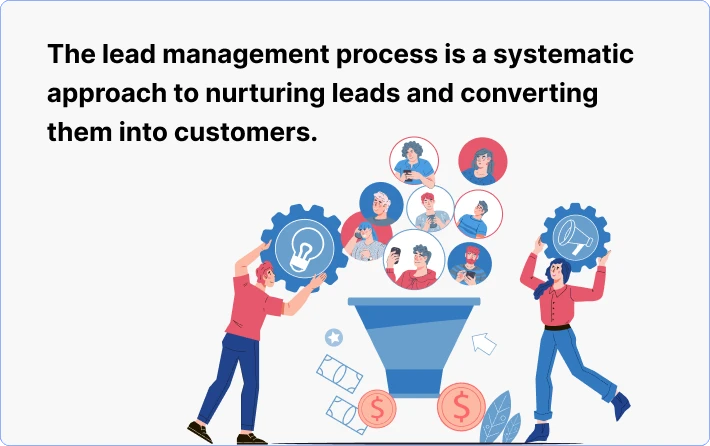
The key steps involved in the lead management process include –
- Identification of potential leads through various marketing strategies
- Using tools to capture lead information
- Tracking the source of each lead to check the efficacy of marketing efforts
- Qualifying leads by setting up criteria to check if a lead is worth the effort
- Routing the leads to the right sales teams or persons
- Engaging with leads
- Tracking lead interactions and engagements across touchpoints
- Moving qualified leads to the sales team for conversion
- Analyzing Lead Management Performance
Why Is Lead Management Important?
Lead management is a vital aspect of a successful business strategy. It plays a key role in converting prospects into customers. Businesses that rely on lead management can optimize their marketing strategies and achieve a better return on investment.
Lead management is important because it helps businesses –
- Understand the source of their leads
- Track interactions with leads
- Guide leads through the sales funnel
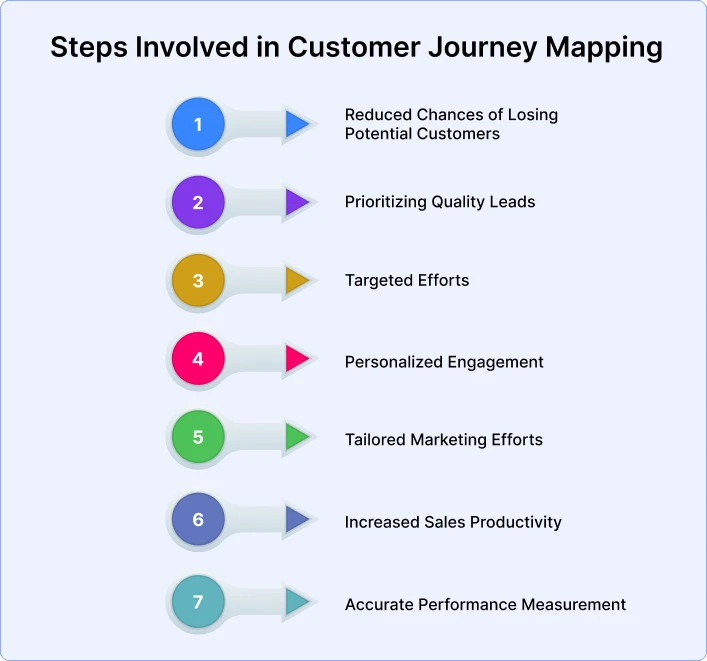
More so, lead management can be used to build trust with prospects, provide personalized communication, and foster long-term relationships for repeat business.
Effective lead management means –
- A business prioritizes leads
- The focus is only on those leads most likely to convert
Lead management can also impact sales and revenue as nurturing and prioritizing leads can contribute to increased sales and better conversion rates. Opportunities for upselling or cross-selling are generated when a business is aware of the needs and preferences of its leads.
Benefits of Lead Management Process
An effective lead management process can impact various aspects of the business. It can add value to sales, marketing, and support, and can help streamline operations. When lead management is strategic, it drives business growth.
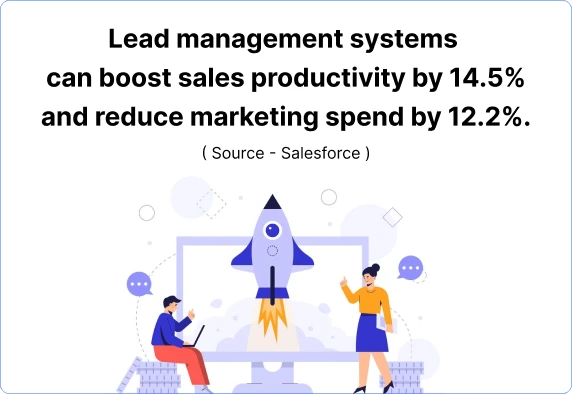
Let’s look at key stats suggesting the benefits of the lead management process –
- Forrester Research says companies that excel at lead nurturing generate 50% more sales-ready leads at one-third lower cost. ( Source – NeilPatel.Com)
- Lead management systems can boost sales productivity by 14.5% and reduce marketing spend by 12.2%. ( Source – Salesforce )
- Companies that segment their leads achieve a 20% increase in sales opportunities. ( Source – DemandGen Report)
- Businesses experience a 451% increase in qualified leads when they use marketing automation. ( Source – WebFx.Com)
Stages of a Lead Management Process
A lead management process typically consists of five stages. These stages provide a structured approach to managing leads and make the sales process efficient. Businesses that focus on the stages of lead management can increase their conversion rates and revenue.
Let’s look at various stages of a lead management process –
Stage 1 – Lead Generation
Lead generation is the first stage of an effective lead management process. In this stage, marketers work on generating leads for the business and develop a detailed understanding of the buyers. Since buyers today search online, marketers adopt an integrated approach to generating leads by combining inbound marketing with outbound techniques.
Key Strategies
- Use social marketing to target users showing interest on social platforms
- Get leads using search marketing
- Approach prospects using email marketing
Stage 2 – Lead Capture
In this stage, the main focus is on continuing the engagement with those who show interest and collect their contact information and relevant details. Lead capturing is done to collect enough information for starting personalized communication with potential leads. This will help move leads down the funnel.
Key Strategies
- Add lead capture forms on landing pages or website
- Design conversion-ready landing pages
- Use pop-ups and slide-ins on web pages
- Add live chat and chatbot on the website
- Provide access to gated content
- Run contests and offer giveaways
Stage 3. Lead Tracking
What next after capturing leads? Lead tracking is the next step where the focus is on collecting additional information about the leads and building a detailed profile. You will need data on lead behavior, preferences, and engagement with your business. Tracking lead activities and engagement follows after that.
Key Strategies
- Implement a CRM system
- Identify and record the source of each lead
- Track the behavior of leads
- Use tracking tools like automation platforms, web analytics tools, etc
- Monitor lead movement through the sales funnel
Stage 4 – Lead Qualification
Lead qualification is a key element of a lead management process. In this stage, a business checks and assesses potential customers based on their level of readiness and interest to buy a product. This stage is critical as it provides deeper insights into customer needs and pain points. Based on that, a business can customize its sales pitch and make an impact.
Key Strategies
- Seek details of your customers
- Ask necessary sales questions
- Use any reliable framework for lead qualification such as a BANT framework
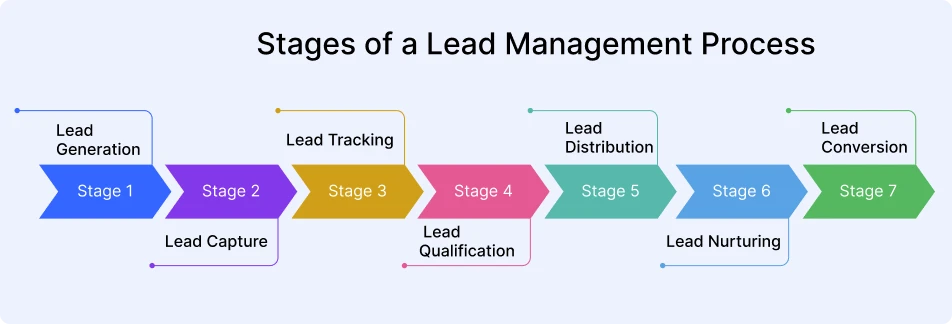
Stage 5 – Lead Distribution
What next after leads are qualified? The next stage is to distribute the qualified leads to sales teams. The key is to distribute leads based on the sales team’s expertise. The ultimate goal of this stage is to let the right salesperson get the right lead for follow-up.
Key Strategies
- Define clear criteria for lead distribution
- Create lead routing rules to automate the process
- Use automation tools for lead distribution
- evaluate the lead distribution process continuously
Stage 6 – Lead Nurturing
After leads are qualified, the next key step is nurturing where the focus is on building relationships and guiding them through the sales funnel. When leads are nurtured, the focus is to provide relevant and valuable information to them at the right time based on their behavior and journey stage.
Key Strategies
- Understand the different stages of the buyer’s journey for effective lead nurturing
- Segments the leads for more personalized lead nurturing campaigns
- Nurture leads through value-added content
- Devise a multi-channel approach to lead nurturing
- Streamline lead nurturing through automated workflows
Stage 7 – Lead Conversion
It’s the ultimate stage of the lead management process where the focus is to convert nurtured leads into paying customers. In this stage, potential leads and sales teams engage in direct interaction for a successful conversion.
Key Strategies
- Identify your sales-ready leads based on different criteria such as lead score, engagement level, etc
- Establish common goals and KPIs for your sales and marketing teams with a focus alignment between both
- Understand the lead’s pain points, and interests, and target them with a personalized approach
- Offer free demos and trial
- Maintain consistent communication with leads
How to Set Up Your Lead Management Process?
Setting up a lead management process is essential for efficiently capturing, nurturing, and converting leads. However, there are several steps to a robust lead management process, and a business needs to follow those steps to drive growth and revenue.
Here is a step-by-step guide on how to set up your lead management process –
1. Devise a Robust Lead Generation Strategy
Reviewing your existing lead generation strategy should be the starting point to set up an effective lead management process. You need to analyze whether the strategy you’re using is effective and helping to capture leads. If it’s working, you must be facing no difficulty in attracting interested prospects and converting them into leads.
On the other hand, if your existing lead generation strategy is faulty, chances are you might be struggling to capture potential customers, let alone convert them. Since there are many strategies for lead generation, you need to experiment with the right ones that are most effective for your business.
Key Points
- Focus more on generating organic traffic from Google
- Optimize your website and blog content with relevant keywords
- Run native ads on popular social platforms such as Facebook and YouTube to leverage direct response marketing
- Develop a variety of lead magnets to align with each stage of the buyer’s journey
2. Group Your Leads Into Different Segments
Managing leads is as challenging as generating them. If you don’t manage your leads well, how can you find the right fit for your products and services? This is where segmentation can help – it is done to group leads into more focused groups based on specific criteria.
Before segmentation, you first need a better understanding of your target audience. When you know your audience’s aspirations, interests, preferences, and pain points, you can easily group them into people who are more likely to convert.
Use these four criteria to segment your audience –
- Demographics ( age, gender, nationality, occupation, etc. )
- Psychographics ( lifestyle, interests, attitudes, values, etc. )
- Geographic location ( areas, region, locality )
- User behavior ( engagement and interactions with the brand )
3. Have a System to Differentiate Between a Good and Bad Lead
Segmenting the leads into different groups will give you a better chance of understanding people who are more likely to convert. However, segmentation alone is not enough to know whether a lead is good or bad for the business. This is why you need a proper system to differentiate between a good and bad lead.
Lead scoring can help you separate a good lead from a bad one. It’s a very effective technique where leads are scored on many attributes. Those attributes can give an idea of whether leads will convert or not. Since each business is unique, you can set custom attributes aligning with the specific needs of your business.
Key Strategies
- Devise a lead scoring system with different attributes or behaviors for your activities or engagement of leads
- Assign higher scores to sales-ready leads or attributes
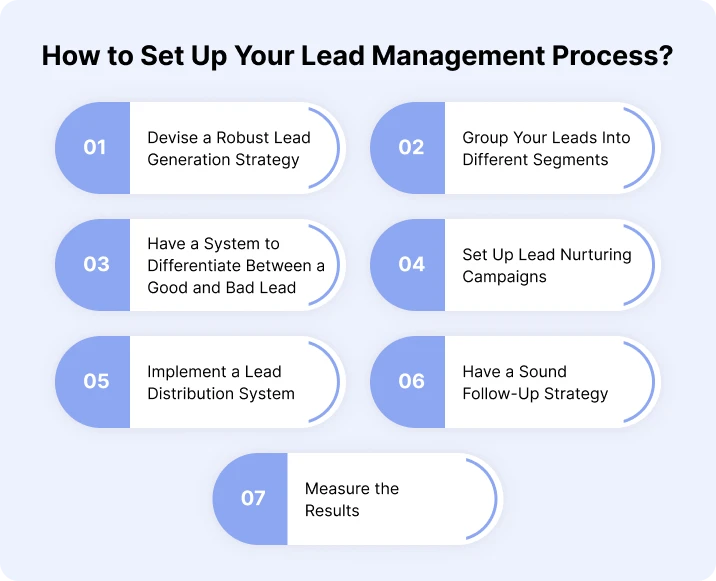
4. Set Up Lead Nurturing Campaigns
Nurturing leads is an important step of a lead management process. In this stage, you engage your target audience by offering them relevant information. The main focus is to support leads and ensure they get value at each stage of their journey.
Your lead nurturing tactics will decide whether leads convert into paying customers. The good thing is that you can use several ways to nurture leads and increase the chances of conversion. As a marketer, you need to build the right strategy to nurture leads and convert prospects.
Key Strategies
- Understand each of your unique buyer personas and use targeted content to nurture those personas
- Use a multi-channel lead nurturing strategy by including email marketing, paid retargeting, social media marketing
- Send personalized and behavioral-triggered emails to your leads
- Do timely follow-ups to keep your leads engaged
5. Implement a Lead Distribution System
What next after leads are nurtured? The next step is to implement a lead distribution system. The purpose is to analyze and evaluate each lead individually and check what makes them unique. After that, you can route the lead to the right sales reps.
Avoid manual allocation of leads as it may consume lots of time. You can set up an automatic lead distribution system instead and save the hassles of sorting and filtering leads for sales teams. However, ensure that only marketing-qualified leads are passed on to the sales teams as this will increase the chances of closures.
Key Strategies
- You can assign leads on a rotation basis or set rules for lead distribution among sales reps
- Ensure leads are distributed to reps based on their expertise, product knowledge, and track record of closing the sale
6. Have a Sound Follow-Up Strategy
Your leads won’t convert as and when you wish. They have their own pace. Trying hard is what you can do best. Some might not even show interest beyond the initial stage and fall off the radar. The key is persistence – don’t let a lead go to waste and try to win them over through your persistence.
This is where having a sound follow-up strategy can help. A standard follow-up strategy won’t work; you must pursue each lead uniquely. It’s equally important to allocate resources differently for following up with sales and marketing qualified leads.
Key Strategies
- Focus more on sales-ready leads and assign an experienced sales rep to follow up
- Use retargeting ads for marketing-qualified leads
- Send emails to leads who are not showing interest after the initial engagement
7. Measure the Results
Lead management is an extensive process that involves a series of steps and efforts. Its real value lies in measuring the performance of each step you take to manage and retain your lead. If you don’t measure the results, how can you know whether the process is effective or not?
Among the key things to measure, make sure you have detailed data on the types of leads you have. You must know how many leads of information, marketing, and sales qualified. You also need to know the number of free trial users you have.
Conversion rates and customer lifetime values are other key metrics you should focus on. They will give insights into the performance of each lead for your business. You should also have data on the total acquisition cost of a lead.
Lead Management Best Practices
Lead management is a strategic approach and it needs proper planning and execution. Some good practices are there that a business can follow to improve its lead management process, resulting in higher conversion rates and increased sales.
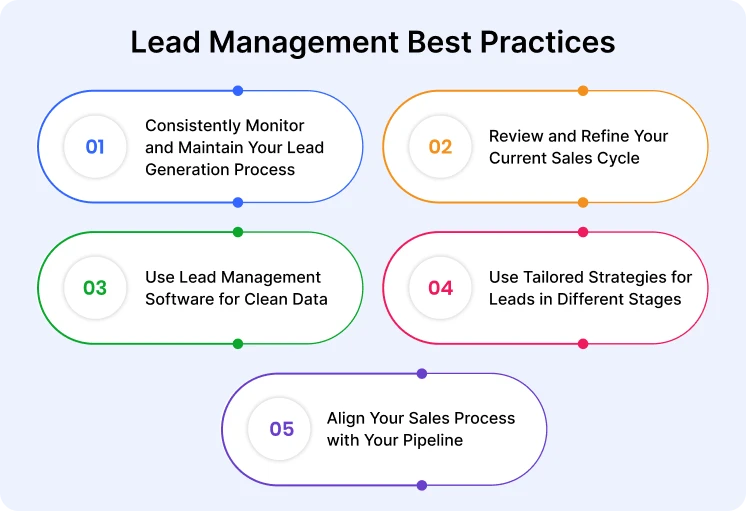
Let’s look at some lead management best practices –
- Consistently Monitor and Maintain Your Lead Generation Process – Your lead generation process is effective as long as you monitor and maintain it. If you don’t, how will you understand what’s working and what’s not? The most important thing is to analyze all the different touchpoints and see what is causing friction in the customer journey.
- Review and Refine Your Current Sales Cycle – Your sales cycle should be efficient and effective if you want to convert most of your leads into paying customers. First, you need to understand your existing sales cycle and identify key actions and decision points. It will help you know the efficacy of your sales process for advancing leads to the next stage.
- Use Lead Management Software for Clean Data – Bad data can dent your lead management effort in a big way. When data lacks quality, managing and organizing leads become harder. The solution lies in adopting a strategic approach to collecting customer data and prioritizing quality over quantity. You can consider collecting data with lead management software to get a more accurate view of your leads.
- Use Tailored Strategies for Leads in Different Stages – Leads vary in their needs, pain points, and preferences. Early-stage leads may have different aspirations compared to mature ones. It’s therefore important to come up with tailored strategies to suit leads in different stages. From building relationships to offering value propositions, your strategy should gradually advance with lead stages.
- Align Your Sales Process with Your Pipeline – Your lead management process must be in alignment with your sales pipeline. If there is no alignment, it will be difficult to manage leads in each stage of the funnel. A clear sales pipeline is essential as it can standardize your sales process and all your sales reps will have the same process to follow.
Strengthen Your Lead Management Process with REVE Chat
Engagement can add value to your lead management effort. The more you engage with your leads, the better conversion rates it will offer.
At REVE Chat, we understand the value of engaging with leads and offering them value at each stage of their journey with your brand.
We have tons of tools for effective engagement. You can use our AI-powered chatbot to respond quickly to your leads and automate various tasks in your lead management process.
Our video chat software and co-browsing features can also facilitate visual engagement with your leads.
You can add our chatbot with the live chat software and improve the quality and speed of responses to your leads.
So, sign up with us and check how our tools can add value to your lead management process.



